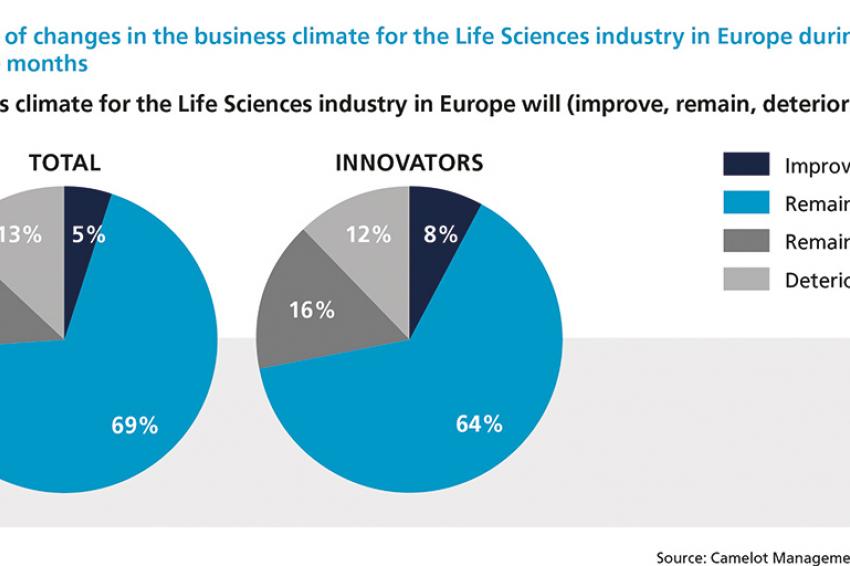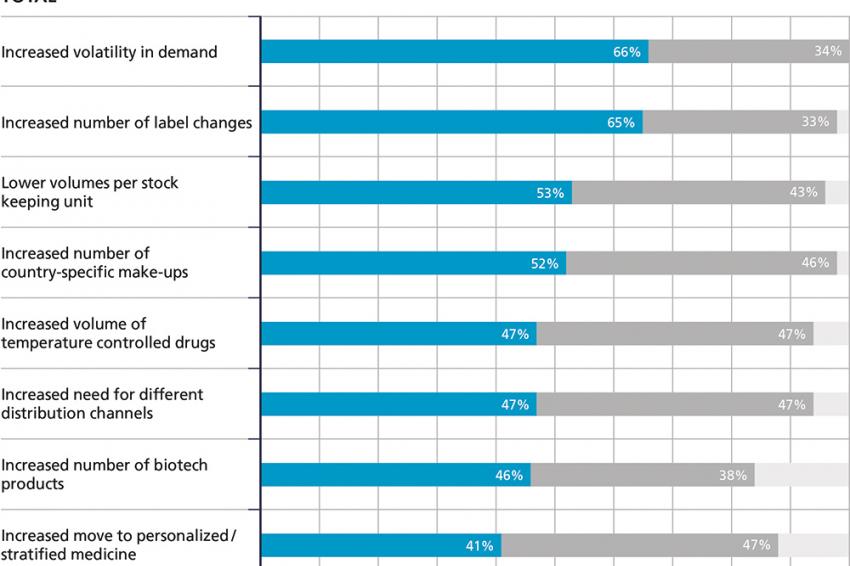Pharma Management Radar survey 2016: Escaping the complexity trap
Camelot’s survey reveals differentiated supply chains as a solution
The good old days are gone — at least with regard to simplicity in business life. This is particularly true for life sciences companies affected by trends increasing the complexity of their business, especially in the supply-chain area. Despite an optimistic view of the current and future business climate, most industry players seem to be aware of this complexity and of the need to respond to it. Many executives share the opinion that differentiated supply chains may be a suitable solution to this challenge. They are at strife, however, with regard to which differentiation strategies in which areas should be the focus.
This is the picture that emerges from the seventh Camelot Management Consultants Pharma Management Radar Survey, a biannual survey that examines the climate in the life sciences industry and takes an in-depth look at a varying current management topic. In January and February, more than 40 executives from globally active pharmaceutical companies based in 13 countries and spread over several continents participated in the online survey.
Companies with a business model predominantly characterized by developing and/or commercializing innovative medicines (“Innovators”) composed around 70% of respondents; roughly one-third were participants from companies predominantly active in the generics segment (“Generics”). Survey participants include the representatives of 70% of the top global pharmaceutical companies including all top five firms. The focus topic of the seventh Pharma Management Radar is differentiated supply chains.
Business Outlook on Record High
Having improved further since the Pharma Management Radar Survey six months ago, the executives’ view of the business climate for the pharmaceutical industry is on a new record level. More than 92% of participants rate the situation “mostly good” or “good” (February 2015: 90%). This particularly applies to the Generics executives, all of whom have a positive impression of the business climate, whereas 12% of Innovators consider the current business climate “mostly bad.” These mood differences are also reflected in the outlook on the economic developments during the next 12 months: The share of Generics expecting the business climate to remain just as good in the next 12 months is higher than the share of optimistic Innovators (79% vs. 64%).
Biotech Drives Growth Expectations in Established Markets
Respondents are even more optimistic with regard to their own business development, confirming the bullish mood expressed in the survey six months ago. More than 90% expect their sales performance to improve while more than three-quarters are confident of being able to raise earnings before interest and tax (EBIT) in 2016. With regard to the regions driving this growth, North America performs very strongly with 68% of respondents having positive demand expectations — a trend that started in the last survey. Growth expectations attributed to various other established markets hint at the very positive development of biotech products. Concerning China, fears of a general economic slowdown are reflected in the fact that expectations are still mostly positive but have declined from half a year ago. Russia, too, is looked at with increasing pessimism.
Investments Focus on China, North America and Germany
Many of the life sciences industry’s regional investment plans for the next 12 months reflect these expectations. China, North America and Germany stand out as particularly strong markets. For China, where investment plans are very widespread among Innovators, the development is not surprising, as this market is expected to continue its growth in the next years. India and some other emerging markets, on the other hand, are more attractive for the Generics as a target of investment.
As one may expect, the will to invest and the general economic optimism are accompanied by growing employment figures. While one year ago nearly half of all respondents had expressed plans to reduce the number of employees, today more than 70% of respondents expect to keep their employment figures constant or even increase staff during the next year. At the same time, however, cost awareness leads to a stable volume of external sourcing. Not surprisingly, external sourcing plays a considerably higher role for Innovators (94% vs. 55%) for whom cost pressure is a particularly relevant topic.
Patent Expiry No Longer Seen as Major Risk
As far as the greatest risks for the companies’ business development during the next 12 months are concerned, patent expiry, which was considered a major risk in 2015, has fallen back massively (27% vs. 48%).
It seems that R&D progress is stronger than previously expected and that industry players are confident that new biotech developments may compensate for expired patents. Instead, cost pressure (63%), increased challenges in the regulatory environment (47%) and political risks in growth markets (33%) are now named as the most relevant risks by representatives of the Innovators and Generics segments.
Considering these results it is not surprising that more than three in four respondents again name cost-related measures as the most important industry trend. Efforts to secure supply reliability and the concentration on emerging markets, too, are considered important trends.
Rising Relevance of Mergers and Acquisitions
In the life sciences industry, the trend for mergers and acquisitions — which reached a peak in 2015 — is expected to continue in 2016. Shire has announced the $6.6 billion acquisition of Dyax. And Generics producer Teva is working on the $2.3 billion takeover of Representaciones e Investigaciones Médicas (Rimsa), to name just two examples of upcoming deals. According to two-thirds of respondents, the number of M&A deals will even increase this year. Corporate growth clearly stands out as the main motivation for current and future M&A activity. For Innovators, access to specific products is particularly important (53% vs. 18%), whereas Generics are more interested in gaining access to new therapeutic areas (36% vs. 29%).
Pharma Supply Chains: What Drives Complexity?
When it comes to trends influencing the complexity of their supply chain, both Innovators and Generics attribute significant power (54%) to lower volumes per stock keeping unit. Especially Innovators feel highly or even very highly affected (65%) by the increased number of country-specific makeups, e.g., different types of packaging demands according to regions. Furthermore, their supply-chain complexity is for obvious reasons affected highly or very highly (66%) by the increased number of biotech products.
The trend of increased volatility in demand is also particularly relevant for representatives of this business model, who have to increasingly handle lower volumes at higher costs. Similarly, temperature-controlled drugs are attributed high or even very high influence by a majority of Innovators but only by one-fourth of Generics’ respondents. This is not surprising, given that the “cold chain” is a prerequisite for many biotech products — a market still mostly dominated by Innovators.
Diverging On Differentiation Criteria
Innovators’ and Generics’ representatives also disagree on the most relevant criteria along which supply chains should be differentiated. Innovators have a strong focus on customer needs, whereas Generics are very much interested in product families and product categories as a criterion to differentiate supply chains.
Generally, answers regarding the various differentiation criteria are very volatile, which adds to the impression that the industry as a whole has not yet found an overall solution for supply chain differentiation. It seems that the industry is unsure about how to differentiate — and the right strategy may in fact depend on the respective company.
Where Differentiation Approaches are Applied
Most companies have realized the relevance of differentiation, and that is reflected in the considerable share of respondents actively dealing with it.
This is particularly true for manufacturing and logistics. In manufacturing, 46% of Innovators and 54% of Generics have initiated or planned to apply different strategies, while different processes are a topic for 46% of Innovators and 31% of Generics. In logistics, Generics mainly focus on different processes, while many Innovators take into account different strategies as well.
Sales and supply-chain planning methods also show relatively high rates of planned or applied differentiation approaches, with Innovators preferring different sales strategies. Though up to one-third of respondents have not yet decided on differentiation approaches, the results clearly indicate that the topic has finally arrived in the pharmaceutical supply chain.
Which Differentiation Procedures are Suitable?
As far as the various possible procedures to encounter increased supply-chain complexity are concerned, enhancing collaboration with customers as well as a transition to flexible manufacturing networks are considered good procedures by the vast majority of respondents — and are already applied by most of them.
Implementation of manufacturing postponement as well as logistics postponement, on the other hand, is much more relevant for Innovators than for Generics (81%/89% vs. 45%/58%). Opinions differ when it comes to vendor-managed inventory systems: While 68% of representatives of both business models advocate this procedure, one-third of participants do not consider it a good procedure. The relatively low rates of companies already applying this procedure might be due to this fact.
To sum up, the survey shows that a considerable amount of differentiation projects have been implemented or at least planned in various subareas. Nevertheless, there is ample potential to further profit from the advantages of differentiated supply chains — which is why the topic will most likely gain further relevance in the near future.











